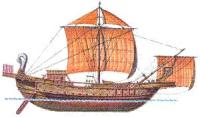 Sometime around the 60 CE, a Greek merchant, whose name is lost to history, wrote a guide, The Periplus of the Erythraean Sea. Periplus is the Latinization of the Greek word περίπλους (periplous, contracted from periploos), literally “a sailing-around.” While Erythraean literally means “red,” the guide includes what we now call the Red Sea, as well as the Gulf of Aden, the Indian Ocean, the Persian Gulf and the Bay of Bengal. The Periplus was organized into 66 short chapters, each usually only a paragraph in length, and served as both a Coast Pilot and merchant’s guide to trading in the ports along the coast. Trade in the region was expanding dramatically as roughly 100 years before the Romans had annexed Egypt and now had access to the Red Sea and Indian Ocean.
Sometime around the 60 CE, a Greek merchant, whose name is lost to history, wrote a guide, The Periplus of the Erythraean Sea. Periplus is the Latinization of the Greek word περίπλους (periplous, contracted from periploos), literally “a sailing-around.” While Erythraean literally means “red,” the guide includes what we now call the Red Sea, as well as the Gulf of Aden, the Indian Ocean, the Persian Gulf and the Bay of Bengal. The Periplus was organized into 66 short chapters, each usually only a paragraph in length, and served as both a Coast Pilot and merchant’s guide to trading in the ports along the coast. Trade in the region was expanding dramatically as roughly 100 years before the Romans had annexed Egypt and now had access to the Red Sea and Indian Ocean.
Beyond written records, such as Periplus of the Erythraean Sea, there have been few artifacts of this trade. Soon archaeologists will start to excavate a shipwreck off the Sri Lankan fishing village of Godavaya. The shipwreck is believed to date from roughly the same period as the Periplus of the Erythraean Sea. The wreck, the oldest located so far in the Indian Ocean, is in 110′ feet of water and is described as “a concreted mound of corroded metal bars and a scattering of other ancient cargo, including glass ingots and pottery, that have tumbled around on the seafloor for hundreds of years amid strong currents and perhaps even the occasional tsunami.” Thanks to Alaric Bond for contributing to this post.
